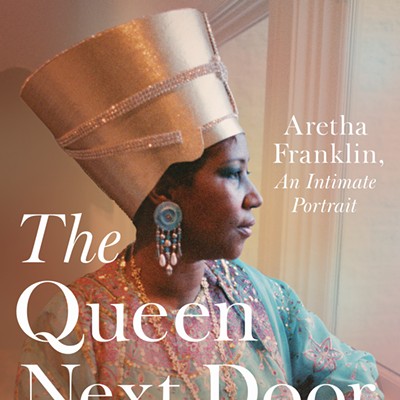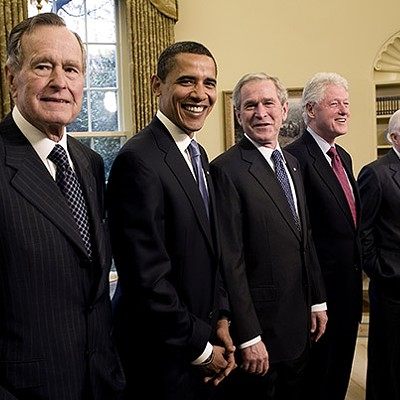On visits from her small town in Missouri to Memphis, her aunt would take her to matinees in the big-city movie palaces. The pair of them would sit in the dark, lost in the shadowy dramas of film noir. Edgy tales of grizzled detectives and dangerous blondes would unfold in highly stylized settings, marked by "heavy chiaroscuro ... skewed compositions and ... stark lighting," as independent curator Trudy Wilner Stack writes in an essay about Morgan's work.
Those film noir characters and their unsettling black-and-white sets have lately made their way into Morgan's art. Her suite of photographic works at Gráficas, a new foothills gallery devoted to serious works on paper, reconfigures the world of the movies. For the show, aptly called Out of the Past, the artist has dipped into her cache of classic movie stills, where such cinema giants as Robert Mitchum and Orson Welles still glower in the shadows.
The original pictures, shot by anonymous studio photographers, are quite wonderful all by themselves. A man in a pale trench coat disappears through a doorway, framed by dark wooden doors, in a scene taken from the movie The Lower Depths. In a still from The Third Man, a woman cheerily waves goodbye as she climbs into an automobile, about to disappear, possibly forever. Another woman in a flowery hat, in the film Out of the Past, smiles radiantly over a café table at a gloomy man in a dark coat, photographed from behind. (These dark men pictured from the back--their emotions concealed--are evidently a staple of film noir.)
These characters, trapped in their movies, are pinned under slanting diagonals, inside tight frames illuminated by high-intensity light. Even the titles are taut, lifted directly from the terse dialogue of old movies. "And that's life my friend" is the name of one picture. "She went looking for the sun" is another.
But Morgan has remade these old photographs, disrupting their pleasant zing of nostalgia and bringing them into the present by adding her own odd elements. And further underlining the passage of time, she creates her pieces with techniques that cover the whole history of photography, from the pinhole camera to digital manipulation.
A former installation artist, Morgan brings some of her old tricks to bear here. If viewers can't literally walk through the works, their eyes can still travel through 3-D spaces compressed onto paper. Sometimes she puts the old movie stills on the computer, poses objects in front of the computerized images and then reshoots the whole thing into one new picture.
For instance, an oddly terrifying porcelain figurine guards the doorway in "And that's life my friend," the picture of the man disappearing. This murky addition by Morgan--is it a nightmare German in lederhosen or a Mexican in embroidered pants?--brings a new level of horror to a tense scene already hinting at final departures and death.
In "... What difference does it make?" a real-life Cupid figure has been placed in front of the picture of the woman disappearing into a car. Cupid is waving his arm, too, just as the woman is waving goodbye, and together, they encapsulate, perhaps, the beginning and end of romance.
Sometimes the artist montages a brand-new image directly into the old pictures. "I only saw her at night," from the movie Out of the Past, has macho Mitchum fleeing into a Mexican movie theater. The actor was shot from the back by the original photographer; with his broad shoulders and rippling muscles straining against the fabric of his pale suit, Mitchum is the very image of a man's man.
The word "cine" is illuminated above him, an ironic commentary by the original filmmaker about the power of movie escapism. But Mitchum may not really be getting away. In the window of the theater, on a sandwich board advertising the movie, a tiny photograph of the artist's face appears underneath the movie title, Out of the Past, gazing steadily at the actor. Not only has she appropriated the name of his film for her own work; she's interrupted the drama. She's back from the future, blocking his route to escape.
If movie technology seemed magic in its heyday, Morgan traverses the whole history of photography in these pieces. Morgan uses a pinhole camera to rephotograph the old image combined with her new elements. She uses film in the pinhole camera, but she scans her new image digitally into the computer and prints them on a digital printer. Softened and blurred by the primitive pinhole, the old movie pictures suggest the fuzzy terrain of memory.
These complex works not only challenge our collective memory; they "mangle" the familiar with the unfamiliar, as Morgan writes in an artist's statement. They disrupt the pleasant nostalgia we feel when we look at cultural artifacts of the romanticized past. We're left not knowing what's real, now or then.
Sometimes the pictures seem too elusive, too hard to grasp, even too hard to see. Yet they have an undeniable intellectual power, which makes them more than welcome at Gallery Row in the foothills, where too many galleries traffic in Day-Glo cacti and cowboy clichés.
Gráficas director Lynnette Hyde Mautner deals in prints and other works on paper by such big names as Christo, Jim Dine, Luis Jimenez and Claes Oldenburg. And since she opened Dec. 1, she's put on a fine exhibition program of local artists. She gets along fine with the neighbors, saying, "People go around to each of the galleries. Each one has something different from the others."
Morgan's work is wonderfully different, a "pastiche of memory, creativity and appropriation."














